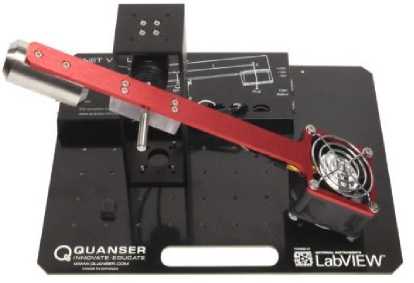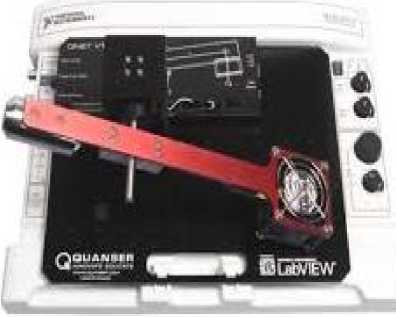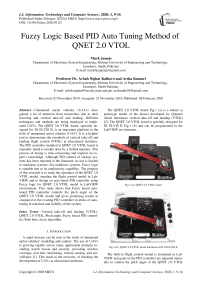Fuzzy Logic Based PID Auto Tuning Method of QNET 2.0 VTOL
Автор: Murk Junejo, Arbab Nighat Kalhoro, Arsha Kumari
Журнал: International Journal of Information Technology and Computer Science @ijitcs
Статья в выпуске: 1 Vol. 12, 2020 года.
Бесплатный доступ
Unmanned aerial vehicles (UAVs) have gained a lot of attention from researchers due to their hovering and vertical take-off and landing. Different techniques and methods are being employed to imple-ment UAVs. The QNET 2.0 VTOL board, specially de-signed for NI ELVIS II, is an important platform in the field of unmanned aerial vehicles (UAV). It is a helpful tool to demonstrate the essentials of vertical take-off and landing flight control (VTOL) at educational institutes. The PID controller installed in QNET 2.0 VTOL board is manually tuned is usually done by a skilled operator. This process of tuning is time-consuming and requires an expert’s knowledge. Although PID control of various sys-tems has been reported in the literature, its use is limited in nonlinear systems. For nonlinear systems. Fuzzy logic is suitable due to its nonlinearity capability. The purpose of this research is to study the dynamics of the QNET 2.0 VTOL model, simulate the flight control model in Lab-VIEW and to design an auto-tuned PID controller using Fuzzy logic for QNET 2.0 VTOL model in LabVIEW environment. This study shows that Fuzzy based auto-tuned PID controller controls the pitch angle of the QNET 2.0 VTOL model and gives promising results as compared to the existing PID controller in terms of auto-tuning in real-time and stability of the system.
Vertical take-off and landing (VTOL), QNET 2.0 VTOL, Pitch angle, Fuzzy based PID controller, Rule base, fuzzy algorithm
Короткий адрес: https://sciup.org/15017098
IDR: 15017098 | DOI: 10.5815/ijitcs.2020.01.02
Текст научной статьи Fuzzy Logic Based PID Auto Tuning Method of QNET 2.0 VTOL
Published Online February 2020 in MECS DOI: 10.5815/ijitcs.2020.01.02
A rapid increase can be seen in the study of unmanned aerial vehicles’ modeling and control. The use of UAVs is growing rapidly across many application domains including search rescue and security, providing wireless coverage, real-time monitoring, remote sensing, and surveillance [1]. This leads to the necessity of teaching the development of UAVs at educational institutes.
The QNET 2.0 VTOL board Fig.1 (a) is a trainer (a prototype model of the drone) developed by Quanser which introduces vertical take-off and landing (VTOL) [2]. The QNET 2.0 VTOL board is specially designed for NI ELVIS II Fig.1 (b) and can be programmed in the LabVIEW environment.

Fig.1 (a). QNET 2.0 VTOL board

Fig.1 (b). QNET 2.0 VTOL board interfaced with NI ELVIS II
The built-in flight control model is simulated in LabVIEW and gains of the PID controller are adjusted manually to control the pitch angle of the QNET 2.0 VTOL board. The PID controller installed is manually tuned by adjusting the gains. This type of tuning requires an expert’s knowledge to perfectly tune the PID controller and requires a lot of time. The major problem occurs if the parameters change abruptly, then the system gets unstable. The PID controller is mainly used for linear systems whereas the VTOL is a nonlinear system. To overcome these issues an auto-tuned Fuzzy based PID controller is presented.
With the help of a comparative study of different controllers used to implement UAVs, it is suggested that fuzzy logic control proves to provide better results in comparison to other controllers [3, 4, 5, 6, 7, 8, 9, 10, 11]. A new auto-tuning method using Fuzzy logic is introduced for tuning of the PID controller on the QNET 2.0 VOL board in LabVIEW. An intelligent algorithm using Fuzzy logic is built, which is capable of auto-tuning the PID controller by using its gain parameters. This tuning method not only will control the pitch angle of the system efficiently but will also reduce the effort of manual tuning as it offers auto-tuning of the controller gain.
The proposed research’s main purpose is to control the pitch angle of QNET 2.0 VTOL. This research addresses the stabilization of the pitch angle of QNET 2.0 VTOL using a fuzzy-based tuning PID method. The main focuses of research include the study of QNET 2.0 VTOL model, design and implementation of fuzzy-based autotuned control logic to adjust intelligently the gain values i.e. Kp , K j and Kd for a stable pitch angle and finally, validate the results using fuzzy control and existing PID control.
The paper is arranged in the following sequence: the literature review is presented in section II. In section III methodology, the system is studied thoroughly and gain parameters, at which the system gets stable pitch angle are found. The system’s transfer function proves to help find out the gain parameters. Once the gain parameters are found then a fuzzy logic block is introduced in the system which takes in error and it's derivative as inputs and the gain parameters as outputs, which then are given to the PID controller. Based on these gain parameter values set of fuzzy rules are developed. Seven membership functions are chosen for all the inputs and outputs and their width is decided based on error and trial experience. Fuzzy blocks are built using these fuzzy rules. The fuzzy blocks replace the position control parameters block and introduce the auto-tuning of the controller gains. In section IV and V, the results are validated with the help of the system identification toolbox in MATLAB, which regenerates the response of the system.
-
II. Literature Review
Список литературы Fuzzy Logic Based PID Auto Tuning Method of QNET 2.0 VTOL
- Hazim Shakhatreh, “Unmanned Aerial Vehicles: A Survey on Civil Applications and Key Research Challenges,” arXiv:1810.09729[cs.RO].
- QNET 2.0 VTOL Board Quanser", Quanser, 2011. Available: https://www.quanser.com/products/qnet-2-0-vtol-board/.
- Zhangli Yang, Lei Li, and Buqing Liu, “Auto-tuning Method of Fuzzy PID Controller Parameter Based on Self-learning System,” 11th International Conference on Fuzzy Systems and Knowledge Discovery, 2014.
- A. Julkananusart and I. Nilkhamhang, “Quadrotor tuning for attitude control based on double-loop PID controller using fictitious reference iterative tuning (FRIT),” in Proceedings of the 41st Annual Conference of the IEEE Industrial Electronics Society, IECON 2015, pp. 4865–4870, November 2015.
- Vijaykumar Sureshkumar Fnu, Kelly Cohen, "Intelligent Fuzzy Flight Control of an Autonomous Quadrotor UAV", Conference paper - January 2014, DOI: 10.2514/6.2014-0992.
- Leticia Cervantes and Oscar Castillo,” Design of a Fuzzy System for the Longitudinal Control of an F-14 Airplane,” soft computing for Intell. Control and Mob. The robot, 2010.
- Arbab Nighat Khizer, Syed Amjad Ali and Dai-Yaping, "Stable Hovering Flight for a small unmanned Helicopter using Fuzzy control, "Hindawi Publishing Corporation Mathematical Problems in Engineering, Vol 2014.
- Arbab Nighat Khizer Syed Amjad Ali and Dai-Yaping," Simpler Fuzzy Logic Controller (SFLC) Design for 3DOF Laboratory scaled Helicopter,” IJRRAS, Vol15Issue2, May 2013.
- Amr Sarhan and Shiyin Qin,” Adaptive PID Control of UAV Altitude Dynamics Based on Parameter Optimization with Fuzzy Inference,” International Journal of Modeling and Optimization, Vol. 6, No. 4, August 2016.
- Theerasak Sangyam, Pined Laohapiengsak, Wonlop Chongcharoen, and Itthisek Nilkhamhang, "Autonomous path tracking and disturbance force rejection of UAV using fuzzy-based auto-tuning PID controller," ECTI-CON2010: The 2010 ECTI International Conference on Electrical Engineering/ Electronics, Computer, Telecommunications and Information Technology, Chiang Mai, Thailand, 2010, pp. 528-531.
- S. M. Sam and T. S. Angel, "Performance optimization of PID controllers using fuzzy logic," 2017 IEEE International Conference on Smart Technologies and Management for Computing, Communication, Controls, Energy and Materials (ICSTM), Chennai, 2017, pp. 438-442.
- Lucio R. Riberio and Neusa Maria F. Oliveira, “UAV Autopilot Controllers Test Platform Using Matlab/Simulink and X-Plane,” 40th ASEE/IEEE Frontiers in Education Conference S2H-1, 2010.
- Tipsuwanporn et al, “Fuzzy Logic PID controller based on FPGA for process control,” IEEE, 2004.
- Qingsi Zhang and Jinfeng Bai, “Application of Fuzzy Logic controller with self-tuning PID parameters for the control system of 40Kg coke oven,” 3rd International conference on instrumentation, measurement, computer, communication and control, 2013.
- Seyed Jamal Haddadi and Payam Zarafshan, “Experimental stability study of an Octrotor using an intelligent controller,” IEEE 2016.
- Yu Jian and Liu Changliang, “Design of self-tuning PID controller with Fuzzy variable parameters based on LabVIEW,” International conference on information and automation Lijiang, China, 2015.
- Tri kuntoro Priyambodo and Andi Dharmawan, “Auto Vertical takeoff and landing on quadrotor using PID-Fuzzy,” Journal of Engineering and applied sciences 12(special issue 3), 2017.
- Ehsan. Abbasi, “Development and implementation of an adaptive fuzzy control system for a VTOL vehicle in hovering mode,” International Journal of control theory and computer modeling (IJCTCM) Vol 7, No.1/2, April 2017.
- Hooman Nasr Azadani and Roozbeh Torkzadeh, “Design of GA Optimized Fuzzy Logic-based PID Controller for the Two Area Non-Reheat Thermal Power System,” 13th Iranian Conference on Fuzzy Systems (lFSC), 2013.
- Francesco Sabatino, “Quadrotor control: modeling, nonlinear control design, and simulation”, Master's Degree Project Stockholm, Sweden June 2015.


